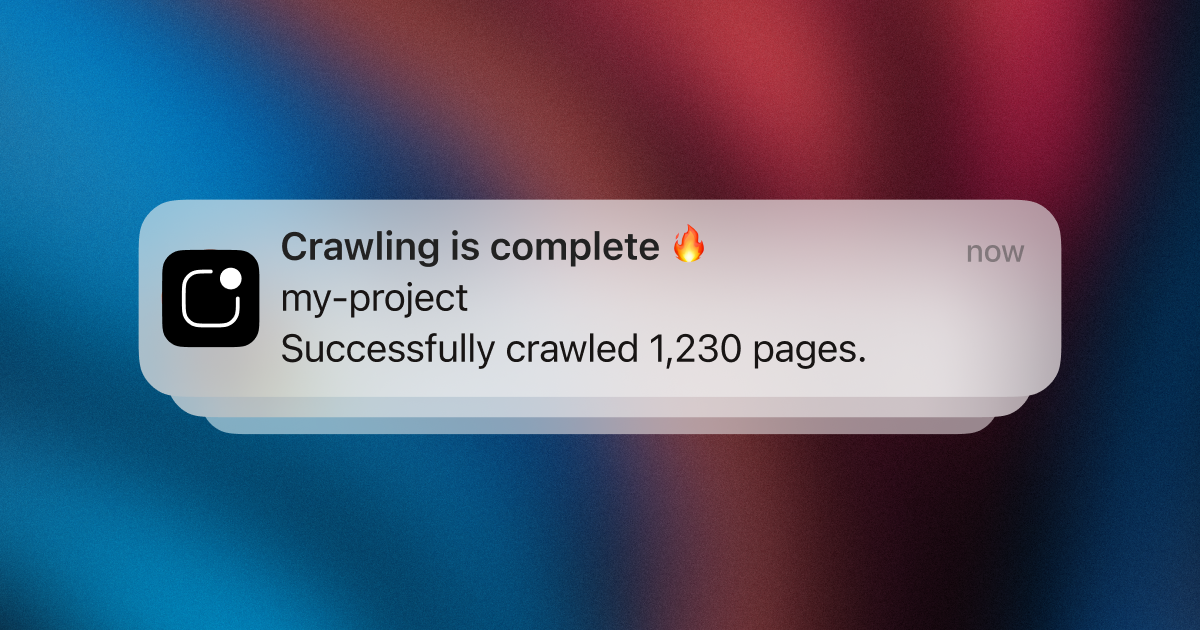These days we can use JavaScript for almost anything, be it a simple function, a complex algorithm, or anything that comes to mind. Usually, what we want JavaScript to do happens very quickly, and we don't even have to wait for it to finish.
Long-running JavaScript tasks are a problem
However, sometimes you are writing a JavaScript code, process, or job that may take a long time to run. For example, you may decide to crawl a website or run a long-running parsing algorithm.
I'm sure almost every developer has, at some point, written a JavaScript code that takes a long time to run. They then had to continuously check the task, wait for it to finish running, and ensure the JavaScript code was working as expected. As you can see, this gets tedious very quickly and wastes time and effort.
Push notifications fix this problem
One common way to solve this is to track the status of our JavaScript code and send a push notification when the code is done running or when it fails. By doing so, we can leave and forget about the long-running JavaScript code and focus on the important things we need to do, and by the time something happens, we will instantly get a push notification to let us know.
To do so, we can use LogSnag to track the status of our JavaScript code. LogSnag is a simple, easy-to-use, robust event tracking and notification system that lets you track your JavaScript code and send push notifications when something happens.
Let's walk you through setting up and using LogSnag to track the status of our JavaScript code.
Setting up LogSnag
- Sign up for a free LogSnag account.
- Create your first project from the dashboard.
- Head to settings and copy your API token.
JavaScript code snippets
Now that we have our account and project setup, we can copy the following code snippet, update the values with your information, and paste it into your code.
Using JavaScript with Fetch
Using JavaScript with jQuery
Using JavaScript with XHR
JavaScript integration details
LogSnag provides several other features that can be used to simplify your job as a developer. For example, suppose you're working with a team. In that case, you can also add the rest of your team to your LogSnag project and allow them to see the status of your JavaScript code and receive push notifications when something important happens.
LogSang also keeps track of your previous events, so you can see what has happened in the past and search through previous events. We found this to be very powerful when we are working on larger projects and need to see what has happened in the past.
In addition, LogSnag allows you to create simple dashboards, charts, and graphs that give you more insight into your code and the events you track.
Other use-cases for LogSnag
- Monitor your CI/CD build status for your JavaScript application
- Monitor your CPU usage in your JavaScript application
- Monitor when database goes down in your JavaScript application
- Monitor high disk usage in your JavaScript application
- Monitor when a user changes their email address in your JavaScript application
- Monitor failed logins in your JavaScript application
- Monitor failed payments for your JavaScript application
- Monitor memory usage in your JavaScript application
- Monitor MySQL downtime in your JavaScript application
- Monitor when a new feature is used in your JavaScript application
- Monitor your Postgres downtime in your JavaScript application
- Monitor Redis downtime in your JavaScript application
- Monitor suspicious activity in your JavaScript application
- Monitor when a user exceeds the usage limit for your JavaScript service
- Monitor when a user is being rate limited in your JavaScript application
- Send push notifications to your phone or desktop using JavaScript
- Track canceled subscriptions in your JavaScript application
- Track your JavaScript cron jobs
- Track when a file is uploaded to your JavaScript application
- Track when a form is submitted to your JavaScript application
- Track payment events via JavaScript
- Track user sign in events in JavaScript
- Track user signup events via JavaScript
- Track waitlist signup events via JavaScript

